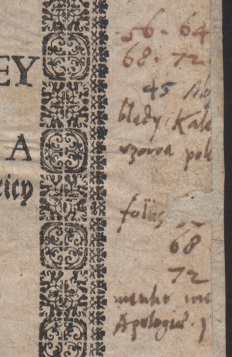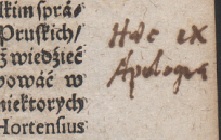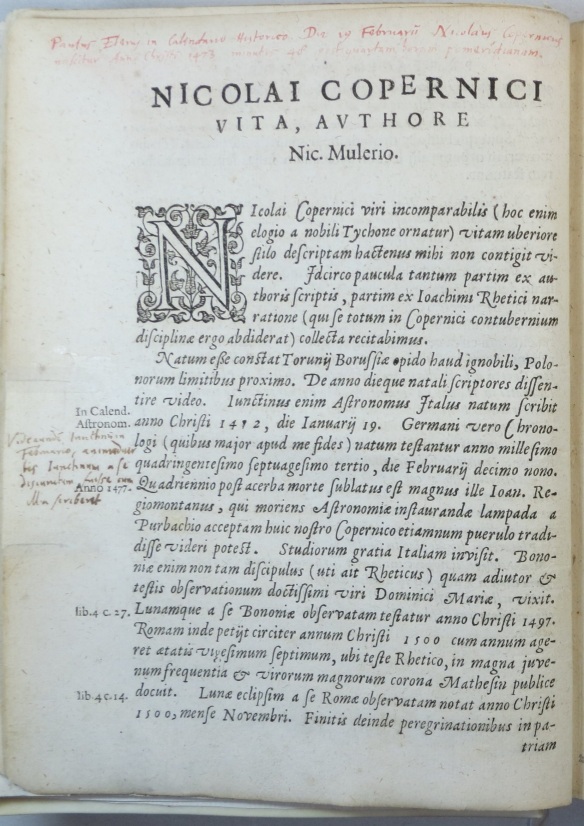Among ca. 2,000 titles that belonged to Joannes Broscius‘s private library and wich are now dissolved in the rich collection of old prints of the Jagiellonian Library in Kraków, one can find a small Polish brochure published in 1644 at the Vilnius print shop of the Basilian order. This book is titled Kalendarz prawdziwy Cerkwi Chrystusowej (‘The True Calendar of the Church of Christ), it was written by Father Jan Dubowicz, an archimandrite of an Orthodox monastery in Derman in Volhynia and survived until nowadays only in three (or four*) copies. Apart from the rarity of this print, I believe it is worth-mentioning for at least three reasons.

The first one is the obvious fact that it was a property of Broscius. Although he used to sign his books, in this case he did not leave a signature, most likely because of the fact that the book was by the 19th century a part of a larger sammelband that could bear other marks of Broscius’s ownership. Despite this lack of an autograph, the book has several other interventions in Broscius’s hand, among them a brief note on the bottom of the title page, which commemorates the fact that the book was a gift from the author: “Dono ipsius authoris”. Along with the extant part of Broscius’s library it creates a marvellous constellation which until now have been explored only partially and which still awaits a proper catalogue and further research based on Broscius’s notes and marginalia.
 The second reason is the fact that Dubowicz’s book makes yet another link in the long chain of Latin, Polish and Ruthenian texts whose authors have been dealing with the issue of the introduction of the reform of calendar and its possible reception by the Uniates. This time we are having a text by an Uniate priest but we would not have chance to read it without Kasjan Sakowicz, a Dubno-based Uniate priest whose brochures, published in 1640 and 1644, kindled the debate over the approval of the Gregorian calendar once again. Dubowicz’s text expands and strengthens the arguments for the Gregorian reform which appeared in previous publications but it also brings some new ones and as such it is important as one of these elements which made the whole debate intense and fiery.
The second reason is the fact that Dubowicz’s book makes yet another link in the long chain of Latin, Polish and Ruthenian texts whose authors have been dealing with the issue of the introduction of the reform of calendar and its possible reception by the Uniates. This time we are having a text by an Uniate priest but we would not have chance to read it without Kasjan Sakowicz, a Dubno-based Uniate priest whose brochures, published in 1640 and 1644, kindled the debate over the approval of the Gregorian calendar once again. Dubowicz’s text expands and strengthens the arguments for the Gregorian reform which appeared in previous publications but it also brings some new ones and as such it is important as one of these elements which made the whole debate intense and fiery.
Finally, the third reason up to a point synthesises the first two. Let’s get back to the title page of this particular copy of Dubowicz’s work (Kraków, Jagiellonian Library, Mag. St. Dr. 36408 I). Apart from the information that Broscius’s copy was a gift received from Dubowicz, we find a marginal note with a series of page numbers.  This annotation, or actually two separate ones, was slightly damaged due to the cutting of the entire volume, but we can certainly say that what Broscius had in mind were the errors of the Julian calendar (“błędy Kale[ndarza]”). After spending some time with books annotated by Broscius, I can say that he quite often limited his handwritten interventions to such lists which served the purpose of indexing the issues and passages important but weren’t necessarily followed by an extensive notes next to the actual fragment of printed text. In this case, references to pages 56, 64, 68 and 72 leave us only with Dubowicz’s text, while in case of a reference to p. 45, which was added in black ink, we find a Latin-Polish marginal note which says that the passage in question is treating about the “errores od Moskwy pokazowane”, “the demonstration of Moscow’s errors”.
This annotation, or actually two separate ones, was slightly damaged due to the cutting of the entire volume, but we can certainly say that what Broscius had in mind were the errors of the Julian calendar (“błędy Kale[ndarza]”). After spending some time with books annotated by Broscius, I can say that he quite often limited his handwritten interventions to such lists which served the purpose of indexing the issues and passages important but weren’t necessarily followed by an extensive notes next to the actual fragment of printed text. In this case, references to pages 56, 64, 68 and 72 leave us only with Dubowicz’s text, while in case of a reference to p. 45, which was added in black ink, we find a Latin-Polish marginal note which says that the passage in question is treating about the “errores od Moskwy pokazowane”, “the demonstration of Moscow’s errors”.

But the fun part (at least for lovers of libri annotati) is brought to us by the lower annotation that contains references to three pages: one which was torn out and to pages 68 and 72 and which is accompanied by, again fragmentary, note which reads: “mentio [?] Apologiae”. In the text on p. 72 we find a direct reference to Broscius which reads that “Venerabilis P. Broscius ślicznie a prawie demonstratiuje, ten błąd ukazuje w pełni a tymi słowy …” (“Venerable father Broscius beautifully and justly shows this error in its fullness and in the following words …”). Four pages earlier, however, Dubowicz also included a larger quotation from Broscius (cf. p. 68: “położę słowa Wieleb[nego] X. Broscjusza” – “I will put here the words of the Reverend Father Broscius”) 
and this time the source of the quotation, however quite obvious in the context of the subject matter of the whole text, has been confirmed by Broscius in a marginal note he had left on the next page: “haec ex Apologia”.

In all these cases both Dubowicz’s and Broscius’s references are going to the latter’s two Apologies of the reformed calendar, two brochures published in Kraków and Warsaw in 1641 which were aimed at giving some additional support in the struggle of Uniate priests with their fellow believers for the introduction of the Gregorian calendar within the Greek Catholic Church. Dubowicz made a good use of Broscius’s works and in this passage he focuses on repeating arguments employed by the Kraków scholar, but what is the most interesting here is the fact that he failed to quote his source properly. Hence the second note left by Broscius on p. 69, which is a correction of the citation of his own text. While the original reads that Tycho Brahe and Johannes Kepler created their astronomical tables during the reign of three Holy Roman Emperors, Rudolph II, Matthias and Ferdinand II, Dubowicz misquoted Broscius’s text and demoted these rulers calling them “great kings” (“wielkich królów”). Hence the marginal note “Cesarzów” – “Emperors”.
Although the nowadays standards of indexing of academic publications and providing precise references to the sources of quotations used in one’s text were quite alien to Dubowicz, Broscius and other scholars of their generation and the footnote as a powerful scholarly instrument was still embryonic at that time, we can treat these marginalia as an early evidence of the “publish or perish” way of thinking. One’s scholarship is important if one’s works are being cited and one’s position inside and outside the acedemia depends on the number and frequency of such references, in this particular case: Broscius’s position within the community of fellow astronomers as well as among men who were in various ways involved in the debate on the calendar reform. Yet the quotations and references are as much important as their exactitute and correctness and it is not only that the number of citations that counts but their quality is important too. If somebody cites an extensive passage of someone elses’s work he should avoid confusing a regular king with the Holy Roman Emperor. If such an error appears in print, perhaps he should consider hiring a better editor or proofreader when it comes to the next publication.

FOOTNOTE:
* The Estreicher’s bibliography lists three copies of Kalendarz prawdziwy: two in Kraków (Jagiellonian Library and Prince Czartoryski Library) and one in Ossolineum. The KVK search, however, brings yet another record of a copy unknown to Estreicher, which is located in the Moscow Museum of the Book of the Russian State Library.
Source of images: Kraków, Jagiellonian Library, Mag. St. Dr. 36408 I



 The second reason is the fact that Dubowicz’s book makes yet another link in the long chain of Latin, Polish and Ruthenian texts whose authors have been dealing with the issue of the introduction of the reform of calendar and its possible reception by the Uniates. This time we are having a text by an Uniate priest but we would not have chance to read it without Kasjan Sakowicz, a
The second reason is the fact that Dubowicz’s book makes yet another link in the long chain of Latin, Polish and Ruthenian texts whose authors have been dealing with the issue of the introduction of the reform of calendar and its possible reception by the Uniates. This time we are having a text by an Uniate priest but we would not have chance to read it without Kasjan Sakowicz, a  This annotation, or actually two separate ones, was slightly damaged due to the cutting of the entire volume, but we can certainly say that what Broscius had in mind were the errors of the Julian calendar (“błędy Kale[ndarza]”). After spending some time with books annotated by Broscius, I can say that he quite often limited his handwritten interventions to such lists which served the purpose of indexing the issues and passages important but weren’t necessarily followed by an extensive notes next to the actual fragment of printed text. In this case, references to pages 56, 64, 68 and 72 leave us only with Dubowicz’s text, while in case of a reference to p. 45, which was added in black ink, we find a Latin-Polish marginal note which says that the passage in question is treating about the “errores od Moskwy pokazowane”, “the demonstration of Moscow’s errors”.
This annotation, or actually two separate ones, was slightly damaged due to the cutting of the entire volume, but we can certainly say that what Broscius had in mind were the errors of the Julian calendar (“błędy Kale[ndarza]”). After spending some time with books annotated by Broscius, I can say that he quite often limited his handwritten interventions to such lists which served the purpose of indexing the issues and passages important but weren’t necessarily followed by an extensive notes next to the actual fragment of printed text. In this case, references to pages 56, 64, 68 and 72 leave us only with Dubowicz’s text, while in case of a reference to p. 45, which was added in black ink, we find a Latin-Polish marginal note which says that the passage in question is treating about the “errores od Moskwy pokazowane”, “the demonstration of Moscow’s errors”.


